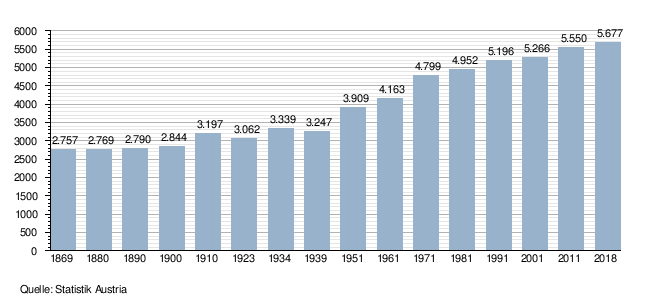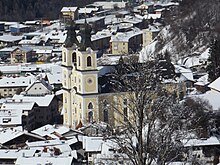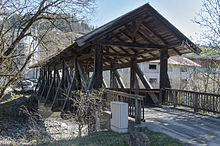Hopfgarten in Brixental
|
market community Hopfgarten in Brixental
|
||
|---|---|---|
| coat of arms | Austria map | |
|
|
||
| Basic data | ||
| Country: | Austria | |
| State : | Tyrol | |
| Political District : | Kitzbühel | |
| License plate : | KB | |
| Main town : | Hopfgarten market | |
| Surface: | 166.33 km² | |
| Coordinates : | 47 ° 27 ' N , 12 ° 10' E | |
| Height : | 622 m above sea level A. | |
| Residents : | 5,630 (January 1, 2020) | |
| Postal code : | 6361 | |
| Area code : | 05335 | |
| Community code : | 7 04 06 | |
| NUTS region | AT335 | |
| UN / LOCODE | AT HOP | |
| Address of the municipal administration: |
Marktplatz 8 6361 Hopfgarten im Brixental |
|
| Website: | ||
| politics | ||
| Mayor : | Paul Sieberer ( ÖVP ) | |
|
Municipal Council : (2016) (17 members) |
||
| Location of Hopfgarten im Brixental in the Kitzbühel district | ||
 Hopfgarten, photographed from a hiking trail on the Hohe Salve |
||
| Source: Municipal data from Statistics Austria | ||
Hopfgarten im Brixental , in the dialect Hopfgåscht , is a market town with 5630 inhabitants (as of January 1, 2020) in the Kitzbühel district in north-eastern Tyrol ( Austria ). The community is located in the judicial district of Kitzbühel .
The market town of Hopfgarten im Brixental with the central market area, the village of Kelchsau , the districts of Pesendorf (Innerer Grafenweg), Penningdörfl and the scattered settlements on the mountains is the largest municipality in the Kitzbühel district and one of the largest in Tyrol with a total area of 166.33 km² .
geography
The main town is nestled in a scenic and climatically favored location on the Brixentaler Ache , the basin of the front Brixental prevents fog and wind.
structure
Of the 16,657 ha municipal area, around 5,600 ha are forest, 2,800 ha are agricultural land and 7,500 ha are alpine pastures. The town center, the market, only accounts for about 130 hectares, i.e. not even 1% of the municipal area.
The market center is around 620 m above sea level, the highest point in the municipality (and at the same time the highest point in the Kitzbühel district) is the summit of the Torhelm im Langen Grund at 2494 m .
Today the market town of Hopfgarten has about 5,300 inhabitants, with the secondary residences about 6,600.
The municipality includes the following seven localities (population in brackets as of January 1, 2020):
- Glantersberg (153)
- Grafenweg (902)
- Gruberberg (73)
- Hopfgarten Market (2626)
- Kelchsau (684)
- Penningberg (898)
- Salvenberg (294)
The community consists of the cadastral communities Hopfgarten Land and Hopfgarten Markt.
|
structure
|
||||||
|
Legend for the breakdown table
|
Neighboring communities
| Wörgl ( district of Kufstein ) | Itter | Söll ( district of Kufstein ) |
| Wildschönau |

|
Westendorf |
|
∗ Hart / Zillert. ,Stummerberg ( district Schwaz ) |
Gerlos , Wald im Pinzgau ( Bez. Zell a.See , Sbg. )
|
history
The history of Hopfgarten is twofold insofar as up to January 1, 1948 there was an independent rural community and a market community, which, however, were always closely intertwined. The history of the rural community is shaped by agriculture, which has been important for centuries and is still important today (currently around 230 farms, including around 70 full-time farmers), which was and is operated on the wide fertile slopes of the mountains, but also by once profitable mining and a flourishing glass industry that declined around 1880 and was known and flourishing throughout Europe (Glashütte Hörbrunn). The particular importance of the market parish was primarily due to the market rights granted around 650 years ago, which is documented in a document from the parish archive from 1362. With this right, which was privileged at the time, the citizens of Hopfgartner were allowed to hold a weekly market every Monday, throughout the year, at which large and small cattle, cheese, lard, leather and other merchandise could be sold. Buying and selling outside the market was strictly prohibited.
In 1869, with 2757 inhabitants, Hopfgarten had more inhabitants than the city of Kufstein (then 2691). With the general economic boom after the Second World War, the old town houses in the market got their new face. In addition to agriculture and trade, tourism, trade and small industry became more and more important. The narrowest market core with historically important buildings is subject to special structural protection provisions by ordinance under the City Center and Site Protection Act. The closed construction of the town houses is comparable to well-known places such as Rattenberg , Hall or Kitzbühel .
Population development

politics
The current mayor of Hopfgarten is Paul Sieberer. He has held this office since 1998.
The local council consists of 17 members, the current composition being as follows:
There is an election cycle of six years for the mayoral election and the municipal council election.
economy
The market community is still fundamentally based on the three relatively equally important economic pillars of agriculture and forestry, trade / trade / small industry and tourism / services. While the situation in the tourism sector is steadily improving, the agriculture and forestry sector has to cope with supra-regional problems due to developments across Europe. There are currently around 160 companies in trade and commerce with around 1240 jobs. The market town itself operates an electricity company as the sole owner that supplies around three quarters of Hopfgartner households and manages around 1,000 hectares of its own forest. The resident company Spiegel Lux is one of the largest producers of traffic signs in Austria.
traffic
- Rail: The municipality's favorable traffic situation - it is on the Salzburg-Tiroler-Bahn of the ÖBB and has two train stations for passenger traffic.
- Road: It is also on Brixental Straße B 170 from Wörgl to Kitzbühel , the connection to the Inntal motorway is only 8 km - guarantees good connections. Nevertheless, the Brixental, as a side valley of the Inntal, is not so extremely traffic-loaded and can therefore offer a very good quality of life.
tourism
In the tourism industry there are currently around 3,000 guest beds in the municipality, the annual number of overnight stays averages 350,000, with the summer and winter half-year roughly being balanced.
The Hohe Salve , Hopfgartner's local mountain, already known as the most beautiful panoramic mountain in the country (“Rigi” of Tyrol) at the turn of the century, is fully developed as a ski area and is connected to the ski area Wilder Kaiser-Brixental (Skiwelt) with almost 100 lifts. Historically, it is worth mentioning that in October 1949 what was then the longest chairlift in Europe with a length of 2850 m and a height difference of 900 m to the Hohe Salve was put into operation.
The “Salvenaland” leisure facility, which was completed in 1998, offers the local population and guests a bathing facility with a bathing lake and pool, a spacious playground and sports fields on an area of around 7 hectares.
Infrastructure
The community maintains three primary schools, a new middle school ( Schulsprengel also for the Itter community), a polytechnic school and a general special school. Around 100 children are currently being looked after in the two existing kindergartens. The Brixental State Music School has existed in Hopfgarten since 1995 and teaches music to more than 400 students. In 2008 a school day nursery was also opened.
Around 60 people live in the senior citizens' home and nursing home of the municipality of Hopfgarten, of whom about 25 fellow citizens are cared for in the nursing ward.
Medical care on site is provided by three general practitioners, two dentists and two veterinarians.
Until 2002, Hopfgarten was the seat of the Hopfgarten District Court .
Culture and sights
The Hopfgartner parish church ("Dom des Brixentales"), which has been renovated in recent years, is considered an important cultural asset. The baroque, double-towered church, which is consecrated to St. Jacob and St. Leonhard, was built between 1758 and 1764 and, due to its size, architecture and prominent position in the middle of the market, is the landmark of Hopfgarten that can be seen from afar. At the end of the restoration work, the new organ, which was inaugurated in September 1998 and built by the Metzler company ( Dietikon / CH), was purchased. With 44 stops on three manuals and pedal, it is one of the most remarkable organs in Tyrol.
- Stegner Bridge
Wooden beam bridge built in 1927 over the Brixentaler Ache
- Other churches in the districts
leisure
Since the construction and commissioning of the "Salvena", the culture and leisure center with the large hall, the culture room and the fitness facility in autumn 1985, a wealth of events has been offered in Hopfgarten. Not only concerts by music bands and groups, classical concerts, theater plays from the home stage, sporting events, balls and Tyrolean evenings are held, but a culture group “all about culture” has been formed, which has particularly taken on cabaret events.
Club life
There is a very lively club life in the market town in the cultural, sporting and social fields. Social life and service to others are indispensable without the two volunteer fire brigades , the local Red Cross office (which was merged with the Westendorf local office at the end of 2004 into a joint “Brixental local office” and now the service from the border area between Hopfgarten and Westendorf provides), the mountain rescue and the social and health district.
There are 2 music bands, 2 male choirs, 2 church choirs, 2 people's theaters, many different sports and cultural clubs and the traditional costume club with the Schuhplattler group in the community. One of the oldest clubs in Hopfgarten is the Schützengilde, which was founded in 1650.
Personalities
- Sons and daughters of the church
- Leupold Scharnschlager (1485–1563), leading Anabaptist personality of the 16th century
- Andreas Benedict Feilmoser (1777–1831), professor of theology in Innsbruck and Tübingen
- Johann Ager (1860–1920) Former Mayor and Honorary Citizen (Golden Cross of Merit, Brotherhood Council)
- Michael Unterguggenberger (1884–1936), Mayor of Wörgl from 1931 to 1934 , implemented ideas of the free economy in Wörgl as an emergency aid program
- Jakob Anton Bucher (1927–2012), academic painter
- Martin Sieberer (* 1968), cook
- Lara (* 1980), singer (pop, folk music)
- People related to the community
- Matthias Wißhofer (1752–1819), from 1781 coadjutor , dean, freedom fighter, polymath and inventor there
Web links
- 70406 - Hopfgarten im Brixental. Community data, Statistics Austria .
- Market town of Hopfgarten im Brixental
- Hopfgarten im Brixental , in the history database ofthe association "fontes historiae - sources of history"
- Hopfgarten gigapixel panorama (8,120 megapixels)
Individual evidence
- ↑ Statistics Austria: Population on January 1st, 2020 by locality (area status on January 1st, 2020) , ( CSV )
- ↑ Mayor on the side of the municipality
-
^ Composition of the local council, accessed on September 18, 2012;
The information on the election results on the municipality's website [1] goes back to 1998, but has not been updated accordingly since 2010.











